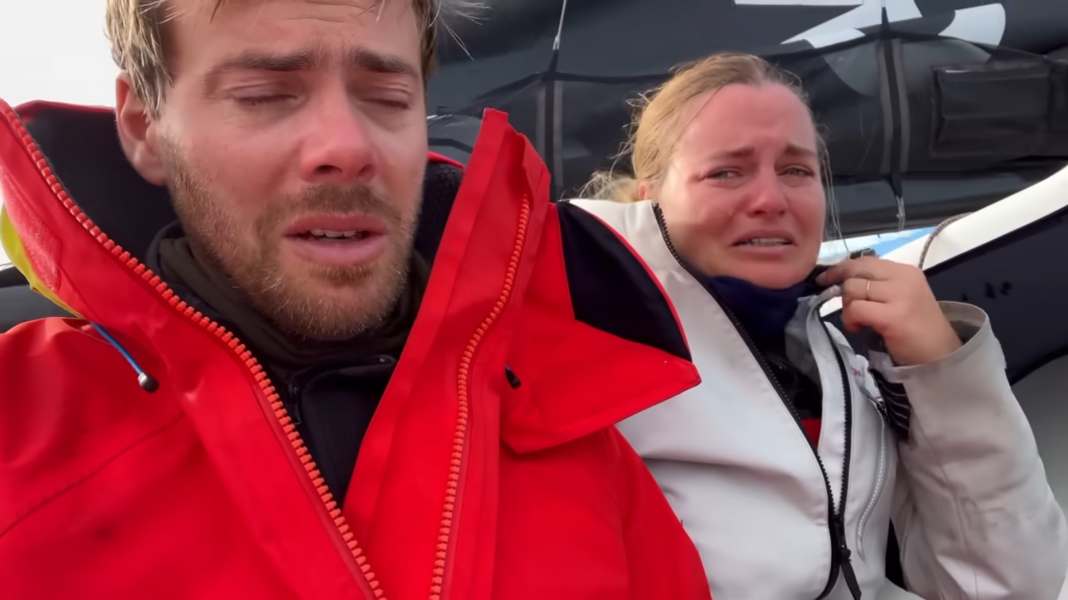
This article was updated after first publication
Belgians Jérôme Delire and Caroline Dieu, participants in the Transat Café L'Orwere the victims of an unusual incident in the Bay of Biscay. According to their own account, a private jet flew over their "Innovad.Group - XLG" three times at extremely low altitude. The aircraft's air pressure was so strong that it caused their Class 40 to capsize within seconds. The gennaker halyard broke in the incident, causing the sail to fall into the water and get caught in the boat's underwater appendages. At this point, the pair were sailing in good conditions for the first time since the start of the race, with a stern wind and high speed, before the incident brought their journey to an abrupt halt.
It had already been stormy before, to several capsizes have arrived.
Contradictory statements
The French navy contradicts this account. According to this, it was not a private jet from which beautiful photos of the boat were possibly to be taken, as the skipper claims, but a Falcon 50 of the French Navy, which was on a surveillance flight. It had received a radar echo without an AIS signal. Already during the first overflight, which had taken place at the prescribed distance of 200 metres, the boat had been in trouble, had started to luff more and more and had been pulled to one side by its gennaker.
This was followed by a second overflight, also at the prescribed distance, during which it became clear that the crew did not require any assistance. There was no third overflight, as claimed.
Complicated rescue operation
The exact cause of the capsize remains unclear. In any case, it presented the sailors with several challenges. Firstly, they had to avoid going overboard, then stabilise the boat and finally recover the sail that had fallen into the water. "We didn't want to lose more than 150 square metres of sail in the water!" explained the sailors about the urgency of the situation. The salvage operation was complicated and took a total of 40 minutes. The pair initially let go of the sail, which was already half in the water, holding it only by the sheet and then gradually freeing it from the underwater appendages. The sail was badly damaged and "quickly torn to shreds", as the couple reported. After the recovery, they set a replacement spinnaker and decided to continue the race.
The incident triggered strong emotional reactions from the couple. In a published video, both were seen crying - an expression of their frustration at the succession of adversities during the race. "There's just a moment when your nerves give way," they explained about this emotional outburst.
The video on Youtube
Difficult course of the race
The incident with the aeroplane was not the first challenge for the pair in this race. They had already been struggling with difficult conditions and technical problems since the start. Right at the start, they suffered damage to the mainsail guide rail. Later, their storm jib tore. These problems were part of a series of difficulties that affected many of the race participants. "I don't think any boat was spared minor or major damage," they reported. Like all the other Class 40 participants, they started La Coruña to avoid a storm. However, according to Race tracker only well behind the competition.
Gross misconduct on the part of the pilot?
The three overflights of an aircraft described above would constitute gross misconduct on the part of the pilot. Jets generate strong wake vortices, especially at the wingtips. These can cause very violent, rotating air movements. The engine thrust of a jet also generates very strong air currents. When flying low overhead, this can generate wind speeds of 100+ km/h. However, a jet would have to fly extremely low (below 50 to 100 metres) to have a noticeable effect on a sailing boat. Such a low pass would be illegal because it is dangerous. Aviation regulations prohibit such low passes over boats. If something like this happened, it would be a serious breach of aviation regulations.

